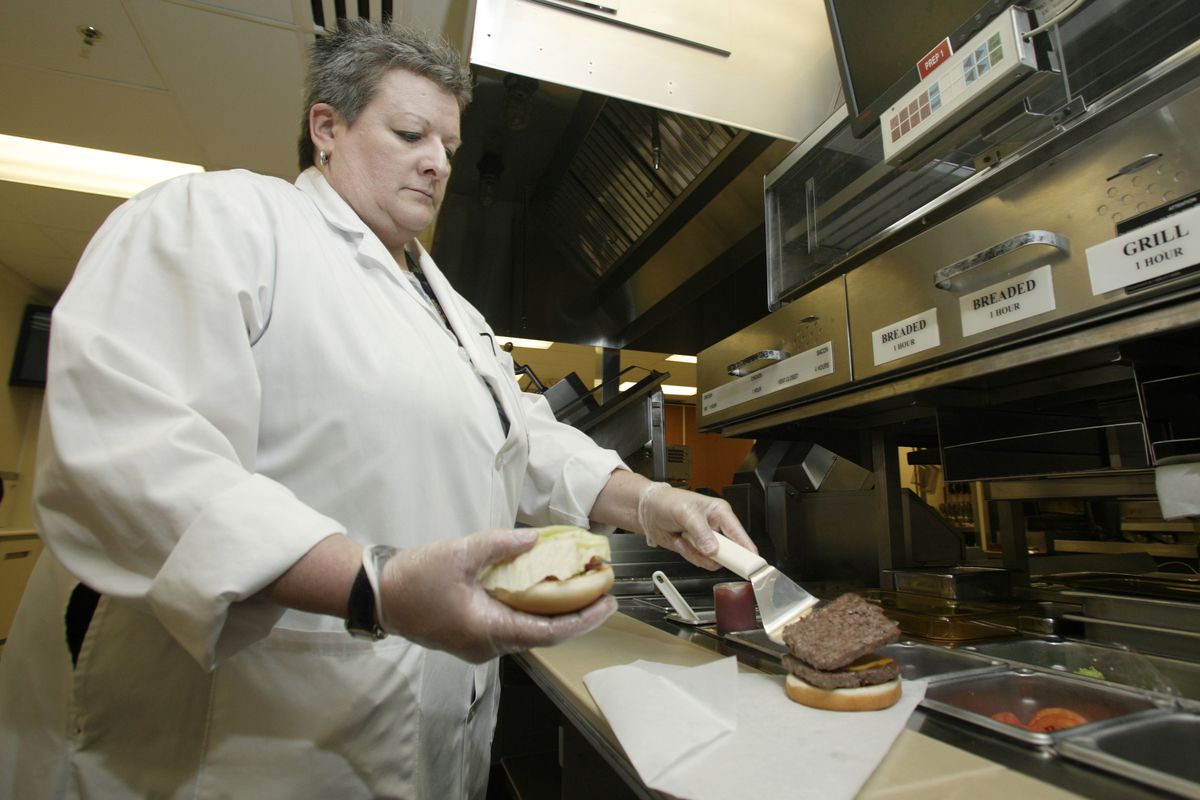Wendy’s burger makeover
After exhaustive testing, Dave’s Hot ’N Juicy debuts
Liz Shires, Wendy’s research and development laboratory coordinator, assembles one of the new Dave’s Hot ’N Juicy Cheeseburgers in the lab at the company’s international headquarters in Dublin, Ohio. (Associated Press)
NEW YORK – When Wendy’s decided to remake its 42-year-old hamburger, the chain agonized over every detail. A pickle chemist was consulted. Customers were quizzed on their lettuce knowledge. And executives went on a cross-country burger-eating tour.
The result? Dave’s Hot ’N Juicy, named after late Wendy’s founder Dave Thomas. The burger – with extra cheese, a thicker beef patty, a buttered bun, and hold the mustard, among other changes – will be served in restaurants starting Monday.
“Our food was already good,” said Denny Lynch, a Wendy’s spokesman. “We wanted it to be better. Isn’t that what long-term brands do? They reinvent themselves.”
For Wendy’s Co., based in Dublin, Ohio, reinvention is critical. That’s why executives at the 6,600-restaurant chain spent the past two and a half years going over burger minutiae during an undertaking they call Project Gold Hamburger. That included deciding whether to switch from white onions on its burgers to red (they did), to change the fat/lean ratio of the meat (they didn’t), or to go with plain or crinkled pickles (they picked crinkled.)
Wendy’s is trying to boost lackluster sales and fight growing competition from much bigger rival McDonald’s on one end and expanding fast-casual chains like Five Guys on the other. Part of the problem is that Americans in the economic downturn are being pickier about how they spend their dining-out dollars. But the biggest issue is that Wendy’s, which hadn’t changed its burger since the chain began in 1969, let its food offerings get stale while competitors updated their menus.
Still, it can be risky to tweak an old favorite. The past is littered with examples of this, including New Coke and Clear Pepsi, which were pulled from store shelves because customers didn’t like them. Wendy’s itself stumbled a few years ago when it rolled out breakfast foods. The company now says its mistake was offering omelets and pancakes, which aren’t conducive to eating on the go.
“We have a lot of catching up to do in some areas,” said Gerard Lewis, Wendy’s head of new product development. “But after we launch this hamburger there will be folks who need to catch up to us.”
How it all began
Project Gold Hamburger started around early 2009, shortly after hedge fund magnate Nelson Peltz bought Wendy’s and combined it with Arby’s. The marriage ultimately failed, with Peltz selling Arby’s to a private-equity firm this summer.
It was clear that Wendy’s had lost its way. In six of the past 11 quarters, the company has reported lower or flat revenue at restaurants open at least a year, a key measure of a company’s growth. And after Thomas died in 2002, Wendy’s struggled to find a new face for ads, at one point running bizarre commercials featuring a man wearing a red pigtailed wig.
Wendy’s also faces strong competition from McDonald’s, which has snatched customers from rivals by remaking itself into a hip, healthy place to eat, with smoothies, Wi-Fi and coffee drinks. Last year, McDonald’s had 49.5 percent of the fast-food burger market in the U.S, up from 41.6 percent in 2002, according to research firm Technomic. During the same period, Wendy’s share fell to 12.8 percent from 14 percent. Burger King’s fell to 13.3 percent from 17 percent.
Anxious to reverse the decline, Wendy’s polled more than 10,000 people about their likes and dislikes in hamburgers. Surveys showed that people like Wendy’s food, but thought the brand hadn’t kept up with the times. So, executives were shipped off to eat at burger joints around the country to measure burger characteristics like fatty flavor, salty flavor and whether the bun fell apart.
“I’ve traveled more with this burger than I have in my entire life,” said Shelly Thobe, Wendy’s director of hamburgers and new platforms.
Then, it was time for Wendy’s to consider the chain’s own burger, ingredient by ingredient. Each time researchers made a tweak, they asked for feedback, visiting research firms nationwide to watch through one-way mirrors as people tasted the variations.
Wendy’s chefs also tested new products at the headquarters in Dublin, just outside Columbus. From test kitchens, they slipped new burger incarnations through little windows into a “Sensory Test Area,” a white-walled room with 16 cubicles where tasting volunteers ranked each burger.
Many suggestions sounded good but didn’t pan out. They tried green-leaf lettuce, but people preferred keeping iceberg because of its crunchiness. They thought about making the tomato slices thicker but didn’t want to ask franchisees to buy new slicing equipment. They even tested a round burger, a trial that was practically anathema to a company that’s made its name on square burgers. (While Wendy’s did not go with the round shape, it changed the patty to a “natural square” with wavy edges because tasters said the straight edges looked processed.)
Among the proposed changes were some golden nuggets. Tasters said they wanted a thicker burger, so Wendy’s started packing the meat more loosely, trained cooks to press down on the patties two times instead of eight. And Wendy’s researchers knew that customers wanted warmer and crunchier buns, so they decided that buttering them and then toasting them was the way to go.
In the end, Wendy’s changed everything but the ketchup. It switched to whole-fat mayonnaise, nixed the mustard, and cut down on the pickles and onions – all to emphasize the flavor of the beef.

